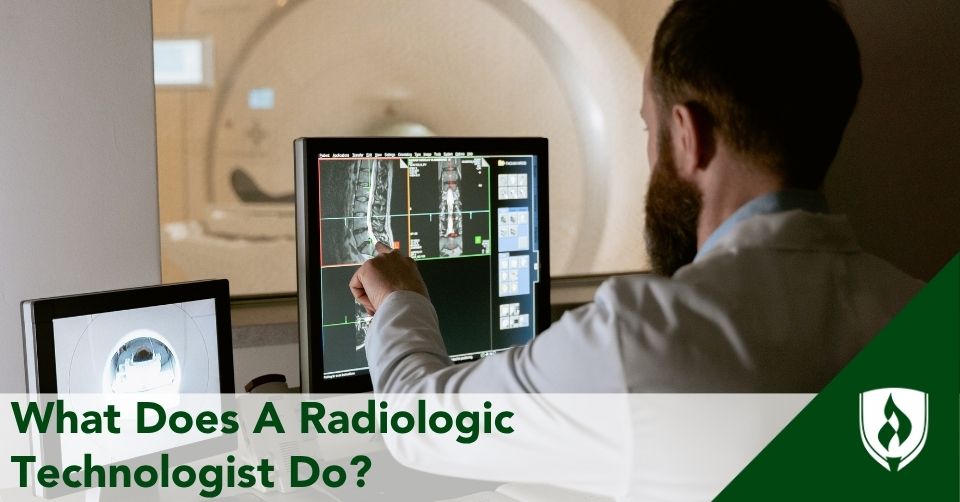What Does a Radiologic Technologist Do
09/05/2025

Radiologic technologists are responsible1 for performing diagnostic imaging examinations that help physicians detect, diagnose, and treat a wide range of conditions. From broken bones and lung infections to cancer and vascular disease, medical professionals rely on the work of radiologic technologists to guide treatment and improve patient outcomes.
But what does a radiologic technologist do on a daily basis, and what makes this role so essential in modern health care?
How Radiologic Technologists Support Diagnosis Through Imaging
Radiologic technologists specialize in operating1 imaging equipment designed to create high-quality images of the inside of a patient’s body. These detailed images allow doctors to pinpoint injuries, identify abnormal tissue, monitor disease progression, or confirm a diagnosis. Depending on their training and work setting, radiologic technologists may perform1 X-rays, computed tomography (CT), magnetic resonance imaging (MRI), or assist in other diagnostic imaging procedures.
Many technologists also take on responsibilities2 such as preparing patients for their exams, positioning them correctly, monitoring radiation dose, and ensuring that the images captured are clear and useful for diagnostic evaluation. Radiologic technologists work closely with radiologists, who interpret the images, but they also interact with nurses, specialists, and other health care professionals throughout the imaging process.
What Happens During a Typical Procedure?
When a patient comes in for an imaging examination, a radiologic technologist typically handles various responsibilities.3 These include reviewing the doctor's orders and setting up the equipment with the correct protocols. They greet the patient, explain what the procedure entails, and ask important safety questions, especially regarding pregnancy, metal implants, or any pre-existing medical conditions. To reduce radiation exposure to other body parts while still getting clear diagnostic images, shielding devices may be used.
Proper patient positioning is essential, requiring the technologist3 to ensure the correct body area is visible, use appropriate angles and distances, and follow established techniques to produce high-quality images. Throughout the process, they also prioritize the patient's comfort and safety, particularly when using advanced or invasive imaging tools. Once the exam is complete, the radiologic technologist confirms that the images meet technical standards before sending them to the radiologist for analysis.
Advanced Imaging Equipment Used by Radiologist Technologists
Radiologic technologists are trained to operate sophisticated diagnostic equipment. Most start with general X-ray machines, which use low doses of radiation to capture static images of bones and certain tissues. However, radiologic technologists can also specialize in other modalities, such as:
- Computed tomography (CT):4 Uses X-rays and computer processing to produce cross-sectional images of internal structures. CT scans are often used in emergency settings and are critical in detecting internal injuries or cancers.
- Magnetic resonance imaging (MRI):5 Uses magnetic fields and radio waves to produce detailed images of organs and soft tissues, such as the brain, muscles, and spinal cord. Magnetic resonance imaging MRI is often used for neurological, musculoskeletal, and cardiovascular assessments.
- Radiation therapy:6 Some technologists pursue roles in radiation therapy, where they deliver targeted doses of radiation to treat cancer patients under a radiation oncologist’s supervision.
No matter the specialization, radiologic technologists must be proficient in the technical aspects of the equipment while understanding patient needs, anatomy, and safety protocols.
Where Radiologic Technologists Work
Radiologic technologists work in a wide range of clinical environments.7 Many are employed by hospitals, where they may rotate through emergency rooms, operating suites, or inpatient departments. Others work in outpatient care centers, private imaging centers, or physicians' offices.
The work environment can influence a technologist’s responsibilities. For instance, those in trauma units may focus on rapid imaging for critical injuries, while those in outpatient clinics may work more closely with scheduled appointments and follow-up care. Technologists in medical laboratories may assist with research or more specialized diagnostic procedures.
Becoming a Radiologic Technologist
The path to becoming a radiologic technologist typically begins with completing an accredited program in radiologic technology.8 These programs can be offered through community colleges, technical schools, or universities and usually lead to an associate degree, although some pursue a bachelor’s degree.
An accredited radiologic technology program9 includes coursework in radiology physics, radiologic positioning and anatomy, image evaluation, radiologic technology and more. Clinical work is a major component of training, giving students supervised hands-on experience with imaging procedures, equipment protocols, and patient interactions.
Graduates are generally eligible to sit for a certification exam offered9 by the American Registry of Radiologic Technologists (ARRT). This national registry of radiologic technologists sets standards for ethical conduct and continuing education. Many states require radiologic technologists to be licensed or certified, and even in states where it’s not mandated, many employers prefer or require ARRT certification.
Radiologic Technologist Specialization and Advancement
As radiologic technologists gain experience, many choose to specialize in advanced modalities. Specialization may require additional training,8 certification exams, or clinical experience in areas such as MRI, CT, or mammography. For instance, technologists who perform mammograms must often be certified in breast imaging and trained to detect breast cancer in its earliest stages using specialized equipment to image breast tissue.
Radiologic Technologists Prioritize Patient Safety and Comfort
Radiologic technologists do more than operate imaging equipment,8 they support patient care on multiple levels.
Attention to Detail: Radiologic and MRI technologists must carefully follow instructions to capture precise images that support accurate diagnoses.
Interpersonal Abilities: These professionals interact closely with patients who may be anxious or uncomfortable. Helping patients feel calm and cooperative is essential for obtaining quality images.
Mathematical Understanding: Technologists may be responsible for calculating appropriate levels of radiation or magnetic resonance used during imaging procedures.
Physical Endurance: The role often requires standing for extended periods and assisting patients with mobility, which can involve lifting or repositioning.
Patient care is not just about comfort, it’s central to obtaining accurate images and minimizing the need for repeat exposures to radiation.
Radiologic technologists are also trained in radiation protection practices to ensure both patients and staff remain safe. This includes understanding radiation dose limits, using shielding devices, and adhering to strict safety protocols outlined by regulatory agencies and professional organizations.
The Role of Radiologic Technologists in Health Care Teams
If they’re working in a busy emergency department, a specialized cancer center, or a rural outpatient clinic, radiologic technologists are health care professionals who help bridge the gap between technology and patient care. They must demonstrate technical skills, critical thinking, attention to detail, and empathy; especially when dealing with patients who are in pain, frightened, or undergoing invasive procedures.
They also collaborate with other health care professionals daily, playing a critical role on a team that includes radiologists, nurses, oncologists, and surgeons. The images they produce serve as the foundation for life-saving diagnoses, surgical planning, and ongoing treatment for many conditions.
Putting Radiologic Technologist Duties Into Perspective
So, what does a radiologic technologist do? They create1 diagnostic images using specialized radiologic equipment, operate advanced technology like CT scanners and MRI machines, ensure patient safety, apply their knowledge of radiation physics and anatomy, and provide compassionate care in fast-paced clinical settings. It’s a field that blends medical imaging, technology, and human connection — all to help patients get the care they need.
If you're just beginning to explore the idea of becoming a radiologic technologist or you're looking to expand your role in a growing field, this profession offers a dynamic career in modern health care, powered by skill, precision, and a commitment to care.
If you're interested in learning about other imaging career options, explore the differences between radiologic technology vs sonography to see which path might be right for you.
1U.S. Bureau of Labor Statistics, “Radiologic Technologists,” Occupational Outlook Handbook, https://www.bls.gov/ooh/healthcare/radiologic-technologists.htm#tab-2 (accessed July 30, 2025). Employment conditions in your area may vary.
2American Registry of Radiologic Technologists (ARRT), “What Do Radiologic Technologists Do?” https://www.arrt.org/pages/about-the-profession/learn-about-the-profession/what-do-radiologic-technologists-do (accessed July 30, 2025).
3Ooi, J. W. L., Er, A. T. W., Lee, W. C., & Chee, H. C. (2021). The 12-hour shift: radiographers' perspectives and its applicability during a pandemic. Radiography (London, England : 1995), 27(2), 512–518. https://doi.org/10.1016/j.radi.2020.11.007
4American Registry of Radiologic Technologists (ARRT), “Computed Tomography,” https://www.arrt.org/pages/earn-arrt-credentials/credential-options/computed-tomography (accessed July 30, 2025).
5American Registry of Radiologic Technologists (ARRT), “Magnetic Resonance Imaging (MRI),” https://www.arrt.org/pages/earn-arrt-credentials/credential-options/mri (accessed July 30, 2025).
6American Registry of Radiologic Technologists (ARRT), “Radiation Therapy,” https://www.arrt.org/pages/earn-arrt-credentials/credential-options/radiation-therapy (accessed July 30, 2025).
7U.S. Bureau of Labor Statistics, “Radiologic Technologists: Work Environment,” Occupational Outlook Handbook, https://www.bls.gov/ooh/healthcare/radiologic-technologists.htm#tab-3 (accessed July 30, 2025). Employment conditions in your area may vary.
8U.S. Bureau of Labor Statistics, “Radiologic Technologists: Job Outlook,” Occupational Outlook Handbook, https://www.bls.gov/ooh/healthcare/radiologic-technologists.htm#tab-4 (accessed July 30, 2025). Employment conditions in your area may vary.
9Rasmussen University, “Radiologic Technology,” https://www.rasmussen.edu/degrees/health-sciences/radiologic-technology/ (accessed July 30, 2025).



